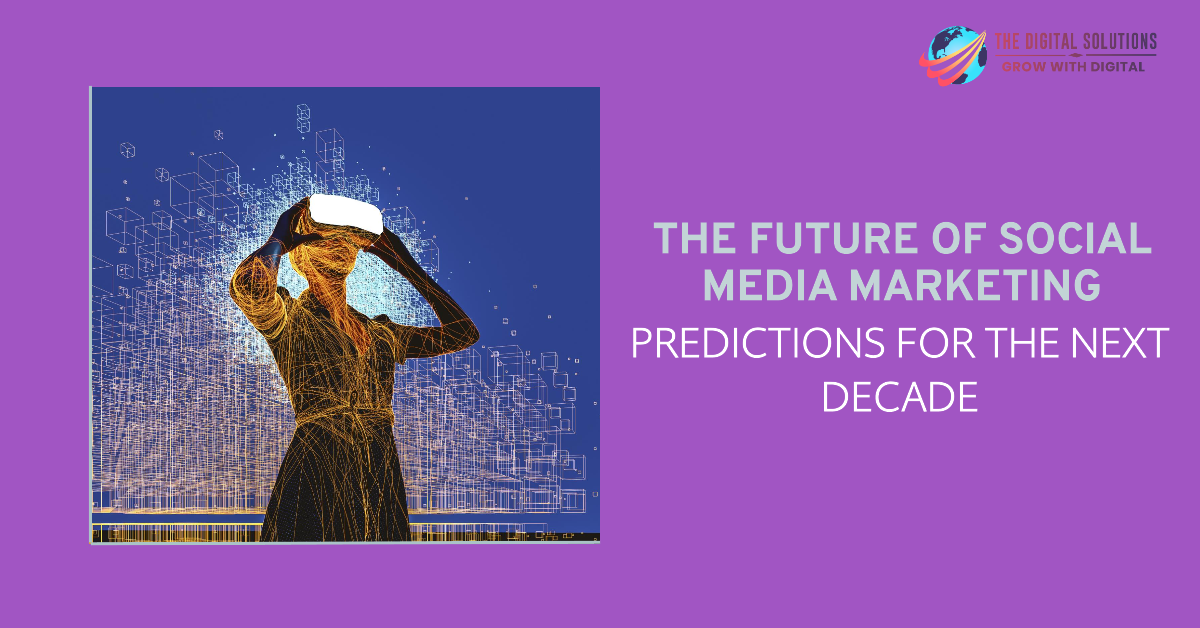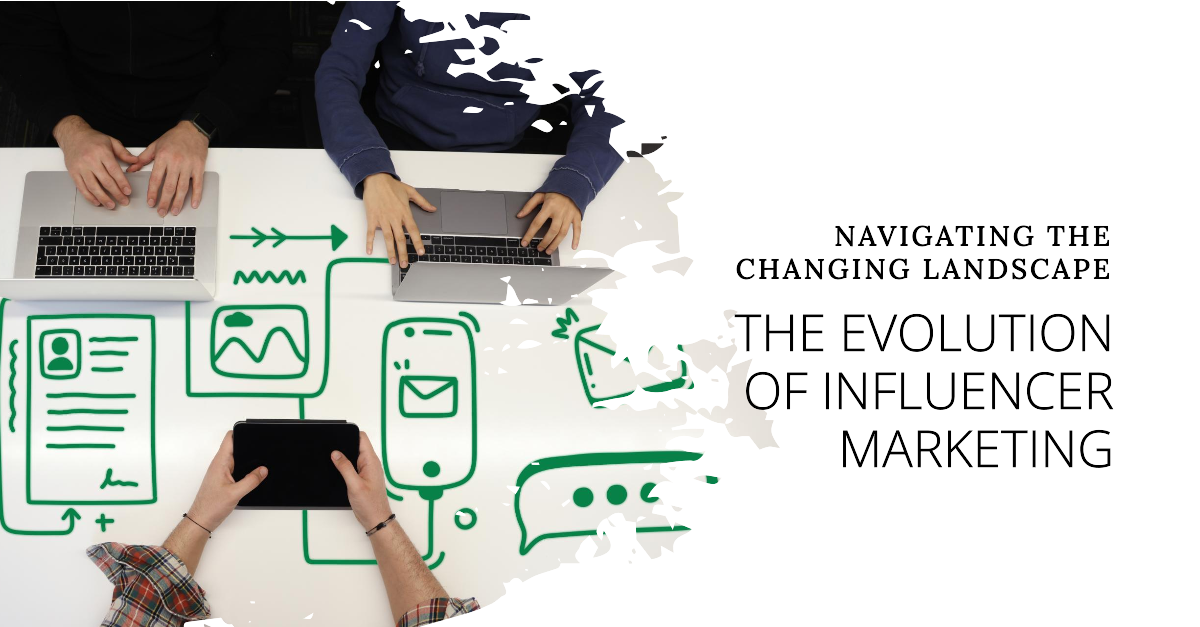The Future of Social Media Marketing: Predictions for the Next Decade

The Future of Social Media Marketing: Predictions for the Next Decade
The social media environment is always changing.New platforms emerge, user behaviors evolve, and marketing strategies need to adapt to stay ahead of the curve. Being up to date on emerging trends is important to us at The Digital Solutions [thedigitalsolutions.in], a top supplier of digital marketing services in Dwarka, New Delhi. Today, we’ll delve into the exciting world of social media marketing for the next decade, exploring key predictions that will shape how brands connect with their audiences.
The Rise of Niche Platforms and Content
The days of using social media in a one-size-fits-all manner are long gone. Today’s social media landscape is becoming increasingly segmented, with niche platforms catering to specific interests and communities. A recent study by [source] revealed that over 70% of social media users are now engaging with niche platforms alongside mainstream ones. For brands, this offers opportunities as well as obstacles.
These niche platforms often boast highly engaged user bases with a strong sense of community. For instance, platforms like Ravelry cater to knitters and crocheters, while Goodreads connects book lovers. Brands targeting these specific audiences can tailor their content and interactions to resonate deeply.
Adapting to Niche Platforms:
- Identify your target audience: Before diving into niche platforms, understand your ideal customer profile and their online behavior.
- Research relevant platforms: Explore niche platforms related to your industry and analyze their functionalities and user base.
- Tailor your content: Develop content specifically for each platform, considering its unique format and user preferences.
- Engage and participate: Don’t just broadcast messages. Actively participate in discussions, respond to comments, and build relationships with the community.
AI-Powered Personalization
Artificial intelligence (AI) is revolutionizing marketing across all channels, and social media is no exception. A study by [source] found that personalized marketing campaigns powered by AI can achieve up to a 70% increase in conversion rates.
AI can analyze vast amounts of data to understand user preferences, past behavior, and demographics. This allows brands to personalize their social media content and ad targeting for maximum impact. Imagine showing custom product recommendations on Facebook based on a user’s recent browsing history, or crafting targeted tweets that address specific pain points for different audience segments.
Benefits of AI Personalization:
- Increased engagement: Personalized content is more relevant and interesting, leading to higher engagement rates.
- Improved conversion rates: By targeting the right users with the right message, brands can convert leads into customers more effectively.
- Enhanced customer experience: Personalization fosters a sense of connection and value for your audience.
Real-World Examples:
- Netflix: Based on a user’s viewing preferences and history, AI is used to recommend content.
- Spotify: Creates personalized playlists based on listening habits and mood.
- Sephora: Recommends makeup products based on a user’s skin tone and beauty goals.
The Power of Community Building
Message broadcasting is no longer the only use of social media. It’s about fostering genuine connections and building a strong community around your brand. A [source] report highlights that over 60% of consumers are more likely to buy from a brand with an active and engaged social media community.
Shift your focus from pure promotion to creating a space where your audience feels valued and heard. Encourage discussions, host interactive polls, and respond to comments and questions promptly. This builds trust and loyalty, which translates into brand advocacy and increased customer lifetime value.
Building a Strong Community:
- Host live Q&A sessions: Interact directly with your audience and answer their questions in real-time.
- Run contests and giveaways: Generate excitement and encourage participation.
- Highlight user-generated content: Feature customer testimonials and reviews to build trust.
- Partner with influencers: Collaborate with relevant micro-influencers to reach a wider audience and foster authenticity.
Examples of Successful Communities:
- GoPro: Known for its vibrant community of adventure enthusiasts who share their experiences using GoPro cameras.
- Starbucks: Creates a coffee-loving community through its #StarbucksLove hashtag, encouraging user-generated content.
- Lego: Hosts interactive challenges and building tips, fostering a sense of creativity and collaboration among Lego fans.

The Evolving Landscape of Influencer Marketing
Influencer marketing has become an integral part of social media marketing strategies. However, the next decade will see a shift towards micro-influencers. A recent report by [source] indicates that engagement rates for micro-influencers (with 10,000-50,000 followers) are often higher than those for mega-influencers with millions of followers.
Micro-influencers often have a more engaged and loyal following, fostering a
The Evolving Landscape of Influencer Marketing (Continued)
Micro-influencers often have a more engaged and loyal following, fostering a sense of authenticity and trust. They are seen as relatable experts within their niche, and their recommendations hold greater weight with their audience. This makes them valuable partners for brands looking to connect with specific target groups.
The Rise of Micro-Influencers:
- Focus on niche expertise: Partner with micro-influencers who have a deep understanding of your industry and target audience.
- Prioritize authenticity: Look for influencers who genuinely align with your brand values and can create content that resonates with their followers.
- Long-term partnerships: Consider establishing long-term collaborations with micro-influencers to build trust and foster deeper connections.
Social Commerce Takes Center Stage
The future of social media is all about seamless customer journeys. A report by [source] predicts that social commerce sales will reach over $3 trillion by 2025. This means social media platforms will become one-stop shops, allowing users to discover products, browse reviews, and make purchases directly within the platform.
Features like shoppable posts and live stream shopping are already gaining traction. Brands can leverage these features to showcase products creatively, answer questions in real-time, and drive conversions directly through social media.
Social Commerce Strategies:
- Optimize product listings: Utilize high-quality product images and detailed descriptions on shoppable posts.
- Embrace live stream shopping: Host interactive sessions with influencers or brand representatives to showcase products and answer customer questions.
- Partner with social media platforms: Collaborate with platforms like Instagram and TikTok to explore their latest social commerce features.
Examples of Social Commerce Success:
- Facebook Marketplace: Allows users to buy and sell products directly within the platform.
- Instagram Shopping: Enables brands to tag products in their posts, allowing users to seamlessly purchase them.
- TikTok Live Shopping: Brands can partner with TikTok creators to host live shopping events and promote products.
The Immersive Era: AR/VR Integration
Augmented reality (AR) and virtual reality (VR) technologies are poised to revolutionize social media experiences. Imagine trying on clothes virtually in a fitting room or attending a concert from the comfort of your home. AR/VR can create interactive and engaging experiences that blur the lines between the physical and digital worlds.
While still in its early stages, AR/VR has the potential to transform social media marketing. Brands can leverage these technologies to:
- Offer product visualizations: Allow users to virtually try on clothes, see furniture in their homes, or experience beauty products before buying.
- Host immersive events: Create virtual showrooms, product launches, or behind-the-scenes experiences.
- Boost user engagement: Immersive AR/VR experiences can generate excitement and create a lasting brand impression.
Examples of AR/VR in Social Media:
- Snapchat Lenses: Offer playful AR filters that can be used for entertainment and brand promotion.
- Facebook 360 Videos: Allow users to explore virtual environments through immersive video experiences.
- IKEA Place App: Enables users to virtually place furniture in their homes using AR technology.
Conclusion
The future of social media marketing promises to be exciting and dynamic. By embracing the trends outlined above, brands can connect with their audiences on a deeper level, drive engagement, and achieve their marketing goals in the next decade. At The Digital Solutions [thedigitalsolutions.in], we stay ahead of the curve by constantly honing our expertise in social media marketing. We can help you develop and implement a data-driven social media strategy that leverages these upcoming trends to achieve success.
Ready to get started? Contact The Digital Solutions today and let’s unlock the potential of social media marketing for your brand!
